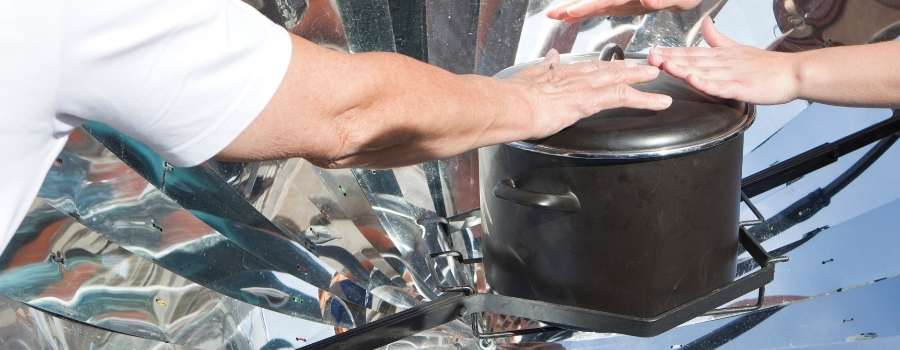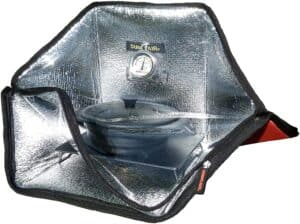
Solar cookers are amazing tools. But they can be finicky too. Whether you’re dealing with clouds, trying to cook when the sun is low in the sky, or muttering under your breath as the wind whips heat away from your food… solar cookers can be frustrating.
In this article, I want to cover how to increase the efficiency of a solar cooker. You need to maximize available sunlight by placing its panels at the proper angle and readjusting them as needed. Proper insulation will help prevent heat loss.
Solar Cookers: The Basics
You can heat leftovers and even cook raw food with the power of the sun. No fuel is needed — just sunshine! Some solar cookers reach temperatures of 400°F, and some models even work well on cloudy days. And they’re great for the planet! These cookers produce zero toxic carbon outputs.
Solar cookers employ reflective panels to redirect the heat of the sun toward a central cooking spot. Many models are easy to transport. Some weigh under two pounds, specially designed for camping. They’re especially good to have in hot, dry spots that don’t allow campfires.
Solar cookers work well for heating leftovers and boiling water, but lightweight options may not generate enough heat to grill or stir-fry raw food.
How To Increase The Efficiency Of A Solar Cooker
There are a number of different ways in which you can increase the efficiency of a solar cooker:
- Proper Insulation
- Use It When The Sun Is Highest
- Cookware and Accessories
- Keep the Wind Away
- Keep Adjusting
Don’t Forget the Insulation
Solar ovens have built-in insulation, which makes them an excellent choice for solar cooking in cold weather. If your solar oven isn’t well insulated, you can always add another layer to the outside.
Most solar cookers aren’t insulated, but there are a number of tricks you could employ.
Try using a solar trap with your solar cooker to retain heat; an overturned glass bowl is an effective option. You can also use plastic bags, the kind designed to keep turkeys moist while they roast in the oven.
Use Your Solar Oven in the Middle of the Day
Most solar ovens function best with high-angle sunlight. When the sun is overhead in the middle of the day, there is more heat available. The angle of the sun when it’s high overhead allows more sunlight to shine into the oven.
Use the Right Cookware
Color is key. Dark colors absorb more sunlight, making more efficient use of the light reflected by the panels on your solar cooker. You can also paint the interior of your solar oven black to increase the absorption of heat.
You’ll also want to choose pots that are wide and shallow. Just make sure they fit!
Thick metals like cast iron take much longer to heat up but also retain more heat than thin materials. This makes them a good choice for a roast, but not the best option for cooking something quickly.
Block That Wind
You’ll need to protect your solar cooker from high winds. Some solar cookers some with windshields, but most don’t. You’ll need to get creative.
Placing your solar cooker directly on the ground helps. Find a place that’s protected from the wind but still in direct sunlight
Readjust
When using a solar cooker, you can’t just set a timer and walk away. This might work for a solar oven at noon (it should still be monitored for safety reasons) but most require active engagement. Some solar cookers need to be adjusted every ten minutes or so for maximum sun exposure.
Types of Solar Cookers
Panel Cookers
This type of solar cooker has one or more flat panels to concentrate the heat of the sun onto the built-in cooking surface. On a warm, sunny day, these inexpensive solar cookers can cook an entire meal in two to three hours.
Panel cookers can be made of metal, reflective fabric, or even cardboard lined with aluminum foil. Many models are easy to fold and lightweight, making them a fantastic option for campers.
Parabolic Solar Cookers
Parabolic solar cookers are made with bowl-shaped reflectors to focus more light directly onto your pot or pan. These solar cookers need to be moved often to continue catching sunlight as the sun moves through the sky. They can generate more heat — around 400°F — than other types of solar cookers and work well for frying food.
Solar Ovens
Solar ovens are great for off-grid homesteads located in sunny climates. Also called solar box cookers, they are used worldwide to decrease fuel costs and carbon emissions. While most solar cookers have an open design, solar ovens have insulated boxes to retain heat, which makes them more efficient on cloudy days.
There are a variety of solar ovens, ranging from science projects built with cardboard boxes to professional models that will allow you to bake cookies and cakes.
How Much Heat Do I Need?
The boiling point of water is 212°F, which almost all solar cookers can manage. If you’re camping in the mountains or if you live at a high elevation, your solar cooker will only need to reach 200°F or so.
Meat should reach an inner temperature of 165⁰F, so solar cookers are perfect for roasts, chicken, and more.
You’ll need higher temperatures for frying or baking. Many parabolic solar cookers and solar ovens reach temperatures of up to 400⁰F!
Some Fan Favorite Solar Cookers
The All-American Sun Oven
This solar oven is by far the easiest to find. It bakes food at temperatures up to 360-400⁰F, making it an excellent choice for baking. The sturdy frame has a capacity of just over one square foot and works best with pots under 7 inches tall. It comes with a built-in thermometer and a cookbook.
The All Season Solar Cooker Camper
This solar cooker reaches temperatures up to 400⁰F. The panel angles are easy to adjust. It has an open-topped, flexible design and functions great even when the sun is low in the sky. It has plenty of room for large pots and pans.
Haines 2.0 Solar Cooker and Dutch Oven Kit
This one cooks food at temperatures of up to 325⁰F. The kit includes a four-quart pot, thermometer, carrying case, and even a windscreen! The panels are easily adjustable to follow the sun. This model is easily transportable, coming it at just under three pounds. The cooking area is one foot by seven inches.
Sunflair Mini Portable Solar Oven
My favorite of the bunch is this Sunflair model, mainly because of its probability. It doesn’t get as hot as the others I mentioned, but I think the portability makes up for this. It can still get water boiling for bag meals and stews, perfect for camping or boating.
This lightweight solar oven is an amazing tool for camping, backpacking, or just cooking at the beach. It heats up to 285⁰F, which is plenty of heat for anything but baking. This kit comes with a silicone pot, cookbook, and thermometer. It folds down to nearly nothing and is extremely easy to carry.
Check Amazon for the current price.
Build Your Own
The book Heaven’s Flame: A Guide to Solar Cookers by Joe Radabaugh provides all of the information that you’ll need to build an efficient solar cooker. This book will tell you how to make an effective solar oven using inexpensive materials like cardboard and aluminum foil.
A Heaven’s Flame Solar Cooker can reach temperatures of 300⁰F.
Get out there and get cooking!

